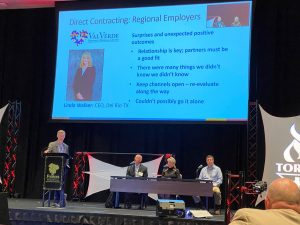Need a Simple Remedy for Cyber Security Burnout?
Direct Contracts Improve Employee and Bottom-Line Health
Need a Simple Remedy for Cyber Security Burnout?
By Krista Adamson, CIC, CISR | Practice Leader: Property and Casualty
It’s not your fault if you’re tired of reading too many cyber security articles citing alarming stats about the increasing frequency and sky-rocketing costs associated with cybercrime.
So, instead of bad news, have some good news; it’s a two-part remedy you can take to ensure your hospital has the best possible cyber protection.

Before I share the remedy, there are two things that stand out about the reality of the situation we find ourselves in.
First, it is incredibly galling that the cyber crooks, who are obviously heartless, have intensified their insidious attacks while our attention is being dominated by the pandemic.
Second, in the past 18 or so months, insurance carriers have not only been raising the premiums they charge for cyber coverage, they have become increasingly selective about what, and even who, they will cover. In the past, if you were disappointed when you didn’t get a discount after implementing security controls, imagine how you will feel if they say you can’t get insurance unless you improve your security!
(If you’re wondering why insurance companies are getting tougher, look no further than ransomware. It is the primary force driving higher premiums and increasingly strict security policies. for instance, Coveware, a ransomware negotiation and response firm, reports the average ransom payment rose 83%; from $84,116 in Q4 2019 to $154,108 in Q4 2020. And, Beazley, a leading insurer we work with, reports ransom payments doubled from June 2019 to June 2020.)
Sadly, where we are today puts a spotlight on why we need some good news and why the remedy I propose is so vital to your future.
Remedy Part 1: Are we ready for renewal?
To get ahead of the crooks and the carriers, you need to implement the first part of the remedy six months before your cyber policies renew. No matter the size of your hospital, asking “Are we ready for renewal?”, well in advance of your renewal date, gives you the opportunity to take control of the situation.
Remedy Part 2: Never go it alone
The second part of the remedy is to get help to determine how ready you are for renewal and identify what can be done to give you the very best renewal outcomes.
In many cases, you will need expert assistance to understand how vulnerabilities you have not yet addressed will impact your ability to get the coverage you need.
In all cases, you will need expert assistance to understand how vulnerable your hospital is to emerging risks such as ransomware and those associated with having your management team work remotely… or even risks you share when your vendors have their people working from home.
Optimizing your risk profile
On the simplest level, cyber insurance is just a tool. In the right hands, even the most basic of tools can create exceptional results. Conversely, in the wrong hands, even the most sophisticated tools can do much more harm than good.
That’s why it’s so important to do an annual checkup months ahead of the actual renewal date. It allows you, with expert help, to assess your risk profile. Further, it gives you time to take the steps necessary to improve your profile so that doing business with you is more appealing to insurance companies.
Here’s where it gets interesting. If you commit to never going it alone, your first source of support is an insurance advisor who knows healthcare, hospitals, and most importantly, your specific situation, business needs, challenges and opportunities. With such a partner, you can take better advantage of the vast array of expertise and resources (other tools) provided by the insurance companies themselves.
Yes, it’s true. The insurance companies, even though they need to make a profit, are on your side when it comes to preparing for, preventing, and mitigating the damage caused by, a cybercrime incident.
How about a risk review?
Regardless of when your cyber policies are up for renewal, having your insurance advisor conduct a risk review will give you invaluable insight into how you can reduce risk, control costs, and get the coverage you need (and only the coverage you need… no overlaps!). At HealthSure, we review your insurance risks and create a Treatment Plan for your healthcare facility. Your Treatment Team will conduct Annual Check Up, to review your Treatment Plan.
When appropriate, your advisor will ask your insurance company, or other insurance companies they may recommend, to do a detail vulnerability scan. Typically, the results can be very complex and technical and often hard to decipher. This where your advisor can be of great service. A great advisor can simplify the complex by interpreting the technical and relating it in practical terms relevant to your hospital’s unique needs. Which means, you can make all your decisions with a very high level of confidence knowing you have the most relevant information and advice.
If you or members of your team are suffering from cyber security burnout, or if you see it coming and want to avoid it entirely, contact us and we will be happy to give you additional information about our remedies and suggest the best, next practical steps you can take.
CHIC Keeps Laying Golden Eggs
Community Hospital Insurance Coalition celebrates three years of success
On October 1, 2021, the Community Hospital Insurance Coalition (CHIC) celebrated its third anniversary.
Since it began in 2018, the successful medical stop-loss reinsurance program has distributed dividends of almost $3 million to its participants. In addition, participants have seen a significant reduction in large claims and an overall decrease in employee health benefit costs.
Created and managed by HealthSure, and owned by 28 participating hospitals, CHIC is entering its fourth year on a high note. Brant Couch, HealthSure’s CEO said, “Based on past performance, I am certain CHIC is going to continue to grow; both in the number of participating hospitals, and in the number and value of the positive outcomes it delivers.”
“We’ve had 100% retention of owner hospitals for the second year in a row,” Brant said. “And, in terms of performance, we estimate the average return on investment for CHIC hospitals is around 11%.”
One of HealthSure’s core principles is “Never Go It Alone”. CHIC is a perfect example of what can happen when rural and community hospitals leaders stop competing and start collaborating. Instead of renting their coverage from big insurance, paying increased premiums every year, and having little or no control over how their benefit dollars are spent, CHIC owners have taken back control by owning their insurance.
Together, they are able to take advantage of proven techniques to customize their benefits, lower administrative fees and taxes, and better manage underlying health risks.
For more information about CHIC, contact your HealthSure risk advisor today.
Direct Contracts Improve Employee and Bottom-Line Health Two success stories reveal benefits of win/win collaboration
By Brant Couch, CIC, CPA
What if the largest employer in your region incentivized its employees to use your hospital first and whenever possible?
What if a nearby tertiary hospital agreed to preferred pricing for your employees whose healthcare needs are your plan’s largest claims For two hospital CEOs, these “what ifs” have become win/win realities.
During the TORCH fall conference, Linda Walker, VVRMC, and CEO of Val Verde Regional Medical Center, in Del Rio, and Nathan Tudor, FACHE, CEO at MidCoast Health Systems, in El Campo joined me in a panel discussion about their recent success negotiating direct contracts.
The discussion was titled Comprehensive Contract Management, a phrase I have been using to describe the approach hospital CEOs and administrators have taken to succeed in the world of modern direct contracting with regional employers and tertiary hospitals.
It is a big, complex job, with significant repercussions both good and – sometimes – bad. In these two cases, Linda and Nathan have been able to negotiate better terms and have seen significant improvements in employee health and health benefit utilization. Plus, the contribution to their bottom lines is measurable and growing.
Keeping Care and Cash Local
During the panel discussion, Linda shared the story of how Val Verde Regional negotiated a direct contract with the local school district, one of the largest employers in the region.
“Our goals were to keep the hospital whole, keep more money local, all while helping keep the school district’s rates down,” she said.
A condensed history of the negotiation starts with the superintendent approaching the hospital prior to the renewal of the school district’s benefits program. Anticipating a significant premium increase, the superintendent was motivated to find an alternative to the traditional big insurance company model.
“When you are with the big companies, premiums go up and there is little incentive (for employees) to keep things local,” Linda said.
The recurring theme behind reaching a win/win result for both parties was having an open, collegial relationship. And key to maintaining that type of relationship is having access to, and sharing, claims data.
This is a key point; big insurance is a bottle neck for rural community hospitals who want to successfully enter into direct contracts. Self-funded hospitals, using an independent third-party administrator (TPA), have much more flexibility and control. Being self-insured meant Linda and her team could use claims data to create an arrangement that was favorable for the hospital and for the school district.
Because the contract terms are based on historical data, Linda and the superintendent agreed to reviewing contact terms annually and adjusting terms as both parties’ experience is considered.
“We anticipated higher volumes in our hospital and clinics, and, if the volume increases as anticipated, the benefits for both our hospital and the school district will be significant,” Linda said.
Win/Win Plus Another Win?
In Val Verde’s case, educating school district employees about the importance of seeking care locally, and the impact it will have on their personal share of healthcare cost, not to mention the viability of their employer’s benefits plan, is essential to success.
In the case of the contract with a tertiary hospital negotiated by Nathan and his team at MidCoast Health in El Campo, the importance of effective employee communication is also a key factor.
Nathan said employees are incentivized to use MidCoast and are steered to go to the tertiary hospital when needed. Apparently, money talks because MidCoast’s plan design means that if an employee receives care outside of the network, they bear more of the cost.
Midcoast is a participant in the healthcare stop-loss insurance program called Community Hospital Insurance Coalition (CHIC). CHIC members have access to detailed data about how their insurance plans are being used. Analyzing the data was the catalyst for initiating the conversation with the tertiary hospital.
“We felt we had a handle on our small claims, but we were not so sure about some of the larger claims we were paying to large tertiary centers in Houston,” Nathan said.
Not thinking of a direct contract at first, Nathan and the MidCoast team approached one of the tertiary hospitals proposing they look at each claim individually to determine the actual cost.
This initial approach led to a broader conversation to determine a methodology for managing costs that both parties could live with. Again, the recurring theme of a collegial relationship, the desire to truly collaborate came to the fore, “It was a very friendly negotiation… everyone wanted to make it work for all involved,” Nathan said.
In this case – as in Val Verde’s – employees saw an immediate advantage when seeking care from the directly contracted healthcare provider. And, from a bottom-line perspective, MidCoast has been able to save a very substantial amount of money on its largest claims.
Never go it alone
Hospital leaders are responsible for entering into contracts that work to their hospital’s advantage. Some contracts are straight forward and easy to agree to. Direct contracts, whether with a regional employer or a tertiary care facility, are not so simple. Each one has its own unique set of circumstances, considerations and of course, participants. Negotiating a contract that delivers win/win results for both parties is most often quite complex, and not something every hospital CEO has a lot of experience doing.
Both Nathan and Linda took advantage of the direct contracting expertise available to them through the TORCH Insurance program managed by HealthSure. That program is also offered nationwide through the Rural Hospital Insurance of America (RHIA), powered by the NRHA and managed by HealthSure, the program gives rural and community hospitals access to a direct contracting specialist as well as the collective wisdom of all the hospitals that have successfully gone down this path.
In both cases, by never going it alone, Linda and Nathan have truly leveraged the collective power of the TORCH and RHIA communities.






0 Comments